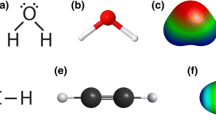Abstract
Chemistry has evolved from a science dominated by mathematics into a science highly dependent on spatial-visual intelligence. Yet the chemical content of introductory courses remains taught essentially the same as 40–50 years ago. Chemistry, today, is recognized by chemists as the molecular science. Yet, school chemistry is alienated from that perception. Thanks to the computer, young people are more comfortable with visual imaging than their instructors were at the same age. Thus the time is rife to reinvigorate chemistry education by means of the visual-spatial approach, an approach wholly in conformance with the way modern chemistry is thought about and practiced.
Similar content being viewed by others
References
Arnheim, R. (1969).Visual Thinking, University of California Press, Berkeley, California.
Atkins, Peter W. (1987).Molecules, Scientific American Library, New York.
Atkins, Peter W. (1992). Educating chemists for the next millenium.Chemtech, pp. 390–392.
Ball, Philip. (1994).Designing the Molecular World. Chemistry at the Frontier, Princeton University Press, Princeton, New Jersey.
Block, Ned. (1983). Mental Pictures and Cognitive Science.The Philosophical Review, XCII:499–541.
Cooper, Lynn A., and Shepard, Roger N. (1984). Turning something over in the mind.Scientific American, 251:114–120.
Coppola, Brian P., and Lawton, Richard G. (1995). Who has the same thing as I do? A blueprint for collaborative learning activities.J. Chem. Educ. 72:1120–1122.
Davies, D., Bathurst, D., and Bathurst, R. (1990).The Telling Image. The Changing Balance between Pictures and Words in a Technological Age, Clarendon Press, Oxford.
de Rosnay, Jöel (1994). Personal communication.
de Vos, W., van Berkel, B., and Verdonk, A. H. (1993). Het isolement van de schoolscheikunde.Tijdschrift voor de Didactiek der beta- wetenschappen, 13:98–109.
de Vos, Wobbe, van Berkel, B., and Verdonk, A. H. (1994).Journal of Chemical Education, 71:743–746.
Dunitz, ?., and Orgel, ?. (1953).
Ebert, J. D. (1992).Chemical and Engineering News, September 21:27–30.
Ege, S. N. (1994).Organic Chemistry. Structure and Reactivity. 3d Ed., D. C. Heath and Company, Lexington, Kentucky.
Eliel, E. L., and Wilen, S. H. (1994).Stereochemistry of Organic Compounds, John Wiley and Sons, Inc., New York.
Faas, Erik (1993). Mentale beelden: beelden of proposities?Psychologie and Maatschappij, 63:115–128.
Fischer, Emil (1891).Ber. Dtsch. Chem. Ges., 24:2683–2687. See: Eliel and Wilen (1994). p. 60.
Fischer, Emil (1894).Ber. Dtsch. Chem. Ges., 27:2985–2993.
Gardner, Howard (1983).Frames of Mind. The Theory of Multiple Intelligences, 2nd Ed., Fontana Press.
Gardner, Howard (1993).Multiple Intelligences. The Theory in Practice, Basic Books. A Division of Hrpers Collins Publs.
Habraken, C. L. (1989). No Man's Land.Proceedings 10th International Conference on Chemical Education, August 20–25, 1989, University of Waterloo, Waterloo, Ontario, Canada.
Habraken, C. L. (1991). Chemici denken in beelden.Chemisch Magazine, pp. 376–379.
Habraken, C. L. (1992). Chemici denken te recht toe, recht aan.Chemisch Magazine, pp. 393–395.
Hammond, George S. (1977). Teaching Chemistry for Tomorow's Citizens. International Conference on Chemical Education, Ljubljana, Yugoslavia.
Hanessian, S., Franco, J., and Larouche, B. (1990). The psychological basis of heuristic synthesis planning—man, machine and the chiron approach.Pure & Applied Chemistry, 62:1887–1990.
Hanson, Robert M. (1995).Molecular Origami. Precision Scale Models from Paper, University Science Books, Sausalito, California.
Heilbronner, Edgar, and Dunitz, Jack P. (1993).Reflections on Symmetry in Chemistry... and Elsewhere, VCH, Weinheim.
Hoffmann, Roald, and Torrence, Vivian (1993).Chemistry Imagined. Reflections on Science, Smithsonian Institution Press, Washington and London.
Kosslyn, S. M. (1980).Image and Mind: Harvard University Press, Cambridge, Massachusetts.
Lagowski, J. J. (1988). The Continuing Attempt at Reform in Science Education.J. Chem. Educ., 65:1
Legon, A. C. (1993). The Nature of Ammonium and Methylammonium Halides in the Vapour Phase: Hydrogen Bondingversus Proton Transfer.Chem. Soc. Rev., 22:153–163.
Levi, Primo (1985).The Periodic Table. Michel Joseph, London.
Lichtenthaler, Frieder W. (1994). 100 Years “Schlüssel-Schloss-Prinzip”: What Made Emil Fischer Use This Analogy?Angew. Chem. Int. Ed. Engl., 33:2364–2374.
Lowe, James N. (1968). Who Will Our Teachers Be?J. Chem. Educ., 45:649–650.
Luisi, P-L., and Thomas, R. M. (1990). The Pictographic Molecular Paradigm. Pictorial Communication in the Chemical and Biological Sciences.Naturwissenschaften, 77:67–74.
Marr, D. (1982).Vision, W. H. Freeman and Company, New York.
Mislow, Kurt (1966).Introduction to Stereochemistry. W. J. Benjamin, Inc., Amsterdam and New York.
Mulliken, R. S. (1952).J. Phys. Chem., 56:801–822.
Newman, Melvin S. (1955).J. Chem. Educ., 32:344.
Newman, Melvin S. (1956).Steric Effects in Organic Chemistry. John Wiley and Sons, Inc., New York, pp 4–5.
Paivio, A. (1986).Mental Representations. A Dual Coding Approach. Oxford University Press, New York.
Pasteur, Louis (1848).Ann. Chim. Phys., 3(24):442.
Pauling, Linus (1960).The Nature of the Chemical Bond, Cornell University Press, Ithaca, NY.
Pylyshyn, Z. W. (1981). The imagery debate. Analog media versus tacit knowledge. In: N. Block (Ed.)Imagery. The MIT Press, Cambridge.
Roberts, Katryn (1995). Cultivating chemical awareness.Education in Chemistry, 32, May: 58.
Shepard, R. N., and Metzler, Jaqueline (1971). Mental Rotation of Three-Dimensional Objects.Science, 171:701–703.
Shepard, R. N., and Cooper, L. A. (1982).Mental Images and Their Transformations, MIT Press, Cambridge, Massachusetts.
Smets, Gerda (1994).Ruimtelijk Inzicht en Beelddenken. Delftse Universitaiere Pers, Delft, Netherlands.
Smith, J. D. (1993).Chemical and Engineering News, January 4:5.
Smithers, A. (1989).Chemistry and Industry: 90–92.
Stevenson, R. (1995). Will chemistry survive?.Education in Chemistry, 32, May:59.
Tobias, Sheila (1992).Revitalizing Undergraduate Science. Why some Thing Work and Most Don't. Research Corporation, Tucson, Arizona.
Tye, M. (1991).The Imagery Debate, The MIT Press, Cambridge, Massachusetts.
van Hezewijk, R., and de Vries, R. (1989). Denken in beelden, denken in taal? Het debat over mentale verbeelding. In Brown, Colin, Hagoort, Peter, and Meijering, Theo (Eds.),Vensters op de geest. Cognitie op het snijvlak van filosofie en psychologie Stichting Grafiet, Utrecht, Netherlands, pp. 82–114.
van 't Hoff, J. H. (1874).Voorstel tot uitbreiding der in de tegenwoordig in de scheikunde gebruikte structuurformules in de ruimte. J. Greven, Utrecht; (1891)Chemistry in Space. Clarendon Press, Oxford.
Wilkinson, G., Rosenblum, M., Whiting, M. G., and Woodward, R. B., (1952).J. Am. Chem. Sec., 74:2125–2126.
Author information
Authors and Affiliations
Rights and permissions
About this article
Cite this article
Habraken, C.L. Perceptions of chemistry: Why is the common perception of chemistry, the most visual of sciences, so distorted?. J Sci Educ Technol 5, 193–201 (1996). https://doi.org/10.1007/BF01575303
Issue Date:
DOI: https://doi.org/10.1007/BF01575303




